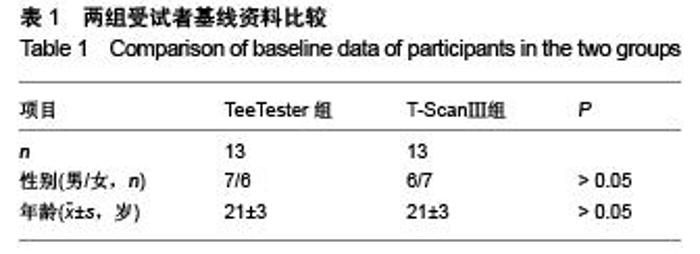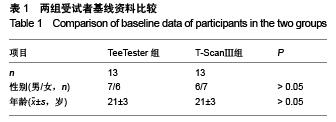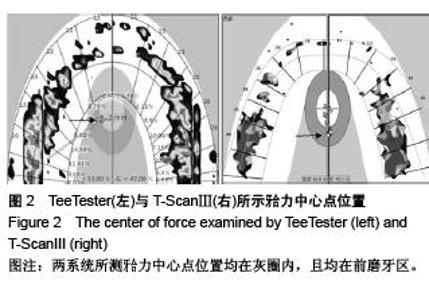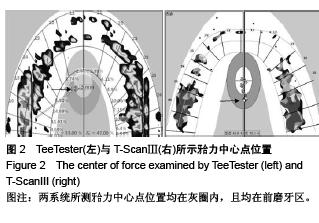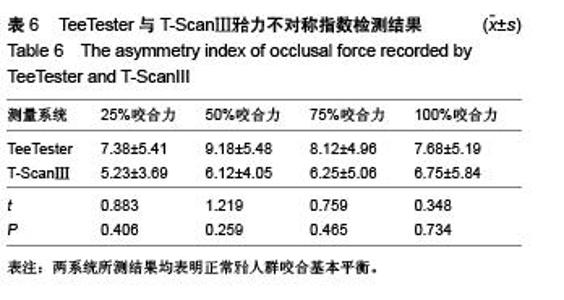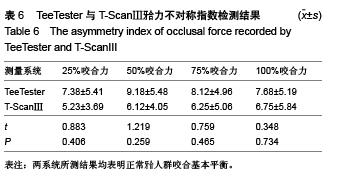Chinese Journal of Tissue Engineering Research ›› 2015, Vol. 19 ›› Issue (51): 8289-8293.doi: 10.3969/j.issn.2095-4344.2015.51.016
Previous Articles Next Articles
TeeTester versus T-ScanIII: assessment of occlusal characteristics in young students with normal occlusion
Zhao Ying, Ding Zhang-fan, Kang Long, Zhou Na, Ren Li-ling, Kang Hong
- Stomatology School of Lanzhou University, Lanzhou 730000, Gansu Province, China
-
Received:2015-10-20Online:2015-12-10Published:2015-12-10 -
Contact:Kang Hong, M.D., Professor, Stomatology School of Lanzhou University, Lanzhou 730000, Gansu Province, China -
About author:Zhao Ying, Stomatology School of Lanzhou University, Lanzhou 730000, Gansu Province, China Ding Zhang-fan, Stomatology School of Lanzhou University, Lanzhou 730000, Gansu Province, China Zhao Ying and Ding Zhang-fan contributed equally to this work. -
Supported by:the National Innovation and Entrepreneurship Action Plan Project of Lanzhou University, No. 201410730151
CLC Number:
Cite this article
Zhao Ying, Ding Zhang-fan, Kang Long, Zhou Na, Ren Li-ling, Kang Hong. TeeTester versus T-ScanIII: assessment of occlusal characteristics in young students with normal occlusion[J]. Chinese Journal of Tissue Engineering Research, 2015, 19(51): 8289-8293.
share this article
| [1] 易新竹.牙合学[M].3版.北京:人民卫生出版社,2012:6-33.
[2] Gümü? HÖ, K?l?nç H?, Tuna SH, et al.. Computerized analysis of occlusal contacts in bruxism patients treated with occlusal splint therapy. J Adv Prosthodont.2013; 5(3): 256-61.
[3] 华咏梅,牟福元,金蕾.正常牙合者咬合功能的研究[J].现代口腔医学杂志,2007,21(5):468-470.
[4] 安薇薇,王邦康,白玉兴.T-ScanⅡ咬合分析记录仪结果可重复性的临床评价[J].北京口腔医学,2006,14(2):112-115.
[5] Makofsky HW. The influence of forward head posture on dental occlusion. Cranio. 2000,18(1):30-39.
[6] Liu CW,Chang YM,Shen YF,et al. Using the T-scan III system to analyze occlusal function in mandibular reconstruction patients:Apilot study. Biomed J.2015;38(1):52-57.
[7] Wang C, Yin XM. Occlusal risk factors associated with temporomandibular disorders in young adults with normal occlusions. Oral Surg Oral Med Oral Pathol Oral Radiol. 2012; 114(4):419-423.
[8] 王旭,杨晓东,艾红军.咬合力测试仪辅助治疗8例冠修复后颞下颌关节紊乱病临床分析[J].山西医药杂志,2014,18(2):163-164.
[9] 于婷婷,宋光保.T-Scan系统的特点及临床应用[J].国际口腔医学杂志,2013,40(1):113-116.
[10] 张燕,李红彩,宁静,等.固定义齿修复以牙槽骨严重吸收牙作为基牙的临床研究[J].牙体牙髓牙周病学杂志,2013,23(2):121-124.
[11] Satheesh BH. Digital Evaluation of Functional Occlusion Parameters and their Association with Temporomandibular Disorders. J Clin Diagn Res. 2013;7(8):1772-1775.
[12] Trpevska V, Kovacevska G, Benedeti A, et al. T-scan III system diagnostic tool for digital occlusal analysis in orthodontics - a modern approach. Prilozi. 2014;35(2): 155-60.
[13] Ma FF, Hu XL, Li JH, et al. Normal occlusion study:using T-Scan III occlusal analysis system. Chinese Journal of Stomatology. 2013;48(6): 363-7.
[14] Cotru ??AM, Mih?escu CS, T?n?sescu LA, et al. Analyzing the morphology and intensity of occlusal contacts in implant-prosthetic restorations using T-Scan dsystem. Rom J Morphol Embryol. 2015,56(1):277-81.
[15] 黄大海,丁仲鹃.T-ScanⅢ数字化咬合分析系统临床应用进展[J].中国实用口腔医学杂志,2011,4(3):181-183.
[16] Kerstein RB, Thumati P, Padmaja S. Force Finishing and Centering to Balance Removable Complete Denture Prosthesis Using the T-Scan III Computerized Occlusal Analysis System. J Indian Prosthodont Soc, 2013, 13(3): 184-8.
[17] Cerna M, Ferreira R, Zaror C, et al. Validity and reliability of the T-ScanIII for measuring force under laboratory conditions. J Oral Rehabil. 2015; 42(7): 544-51.
[18] 程慧娟,耿屹,张富强.正常牙合牙尖交错位咬合的T-ScanⅡ系统分析[J].上海口腔医学,2012,21(1):62-65.
[19] 胡志刚,程辉,郑明,等.正常牙合牙尖交错位咬合平衡的定量研究[J].中华口腔医学杂志,2006,41(10):618-620.
[20] Yamada K, Hanada K, Sultana MH. The relationship between frontal facial morphdogy and occlusal force In orthodontic patients with temporomanderdisorder. J Oral Rehabil.2000; 27(5):413-421.
[21] 皮晰.口腔解剖生理学[M].6版.北京:人民卫生出版社,2007: 293-294.
|
| [1] | Chen Ziyang, Pu Rui, Deng Shuang, Yuan Lingyan. Regulatory effect of exosomes on exercise-mediated insulin resistance diseases [J]. Chinese Journal of Tissue Engineering Research, 2021, 25(25): 4089-4094. |
| [2] | Chen Yang, Huang Denggao, Gao Yuanhui, Wang Shunlan, Cao Hui, Zheng Linlin, He Haowei, Luo Siqin, Xiao Jingchuan, Zhang Yingai, Zhang Shufang. Low-intensity pulsed ultrasound promotes the proliferation and adhesion of human adipose-derived mesenchymal stem cells [J]. Chinese Journal of Tissue Engineering Research, 2021, 25(25): 3949-3955. |
| [3] | Yang Junhui, Luo Jinli, Yuan Xiaoping. Effects of human growth hormone on proliferation and osteogenic differentiation of human periodontal ligament stem cells [J]. Chinese Journal of Tissue Engineering Research, 2021, 25(25): 3956-3961. |
| [4] | Sun Jianwei, Yang Xinming, Zhang Ying. Effect of montelukast combined with bone marrow mesenchymal stem cell transplantation on spinal cord injury in rat models [J]. Chinese Journal of Tissue Engineering Research, 2021, 25(25): 3962-3969. |
| [5] | Gao Shan, Huang Dongjing, Hong Haiman, Jia Jingqiao, Meng Fei. Comparison on the curative effect of human placenta-derived mesenchymal stem cells and induced islet-like cells in gestational diabetes mellitus rats [J]. Chinese Journal of Tissue Engineering Research, 2021, 25(25): 3981-3987. |
| [6] | Hao Xiaona, Zhang Yingjie, Li Yuyun, Xu Tao. Bone marrow mesenchymal stem cells overexpressing prolyl oligopeptidase on the repair of liver fibrosis in rat models [J]. Chinese Journal of Tissue Engineering Research, 2021, 25(25): 3988-3993. |
| [7] | Liu Jianyou, Jia Zhongwei, Niu Jiawei, Cao Xinjie, Zhang Dong, Wei Jie. A new method for measuring the anteversion angle of the femoral neck by constructing the three-dimensional digital model of the femur [J]. Chinese Journal of Tissue Engineering Research, 2021, 25(24): 3779-3783. |
| [8] | Meng Lingjie, Qian Hui, Sheng Xiaolei, Lu Jianfeng, Huang Jianping, Qi Liangang, Liu Zongbao. Application of three-dimensional printing technology combined with bone cement in minimally invasive treatment of the collapsed Sanders III type of calcaneal fractures [J]. Chinese Journal of Tissue Engineering Research, 2021, 25(24): 3784-3789. |
| [9] | Qian Xuankun, Huang Hefei, Wu Chengcong, Liu Keting, Ou Hua, Zhang Jinpeng, Ren Jing, Wan Jianshan. Computer-assisted navigation combined with minimally invasive transforaminal lumbar interbody fusion for lumbar spondylolisthesis [J]. Chinese Journal of Tissue Engineering Research, 2021, 25(24): 3790-3795. |
| [10] | Hu Jing, Xiang Yang, Ye Chuan, Han Ziji. Three-dimensional printing assisted screw placement and freehand pedicle screw fixation in the treatment of thoracolumbar fractures: 1-year follow-up [J]. Chinese Journal of Tissue Engineering Research, 2021, 25(24): 3804-3809. |
| [11] | Shu Qihang, Liao Yijia, Xue Jingbo, Yan Yiguo, Wang Cheng. Three-dimensional finite element analysis of a new three-dimensional printed porous fusion cage for cervical vertebra [J]. Chinese Journal of Tissue Engineering Research, 2021, 25(24): 3810-3815. |
| [12] | Wang Yihan, Li Yang, Zhang Ling, Zhang Rui, Xu Ruida, Han Xiaofeng, Cheng Guangqi, Wang Weil. Application of three-dimensional visualization technology for digital orthopedics in the reduction and fixation of intertrochanteric fracture [J]. Chinese Journal of Tissue Engineering Research, 2021, 25(24): 3816-3820. |
| [13] | Sun Maji, Wang Qiuan, Zhang Xingchen, Guo Chong, Yuan Feng, Guo Kaijin. Development and biomechanical analysis of a new anterior cervical pedicle screw fixation system [J]. Chinese Journal of Tissue Engineering Research, 2021, 25(24): 3821-3825. |
| [14] | Lin Wang, Wang Yingying, Guo Weizhong, Yuan Cuihua, Xu Shenggui, Zhang Shenshen, Lin Chengshou. Adopting expanded lateral approach to enhance the mechanical stability and knee function for treating posterolateral column fracture of tibial plateau [J]. Chinese Journal of Tissue Engineering Research, 2021, 25(24): 3826-3827. |
| [15] | Zhu Yun, Chen Yu, Qiu Hao, Liu Dun, Jin Guorong, Chen Shimou, Weng Zheng. Finite element analysis for treatment of osteoporotic femoral fracture with far cortical locking screw [J]. Chinese Journal of Tissue Engineering Research, 2021, 25(24): 3832-3837. |
| Viewed | ||||||
|
Full text |
|
|||||
|
Abstract |
|
|||||
